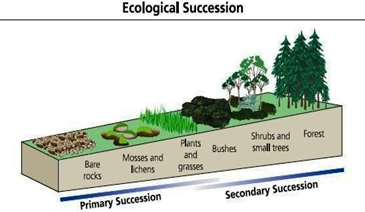Mains Daily Question
Nov. 6, 2019
Q. What are the different types of ecological succession? In this light also discuss the significance of ecological succession?
Structure of the answer:
- Introduction
- Types of ecological succession
- Significance of ecological succession
- Way forward
Ecological succession is the steady and gradual change in a species of a given area with respect to the changing environment. The ultimate aim of this process is to reach equilibrium in the ecosystem. The community that achieves this aim is called a climax community. Further, in an area, the sequence of communities that undergo changes is called sere.
In this background there are following types of Ecological Succession:
- Primary Succession: It is the succession that starts in lifeless areas such as the regions devoid of soil.
- Secondary succession: It occurs when the primary ecosystem gets destroyed. For Ex- a climax community gets destroyed by fire. It gets recolonized after the destruction (secondary ecological succession).
- Cyclic Succession: This is only the change in the structure of an ecosystem on a cyclic basis.
- Autotrophic Succession: It is characterised by early and continued dominance of autotrophic organisms like green plants.
- Allogenic Succession: In this the replacement of the existing community is caused largely by external condition and not by the existing organisms.
- Autogenic Succession: In this the community itself, as a result of its reactions with the environment, modifies its own environment and thus causing its own replacement by new communities.
Ecological succession is a very important form of grown and development of an ecosystem as a whole. Some of the points signifying the same are as follows:
- The sole purpose of ecological succession is for an ecosystem to reach a state of balance.
- It is the process by which communities of an ecosystem changes in a defined and its directional way over time.
- Through this process, a relatively unliveable land is slowly converted into a thriving and vibrant ecosystem.
- It allows new areas to be colonized and damaged ecosystems to be recolonized, so organisms can adapt to the changes in the environment and continue to survive.
Thus, the ecological succession is important for the survival of the existing species as well as emergence of new species.


